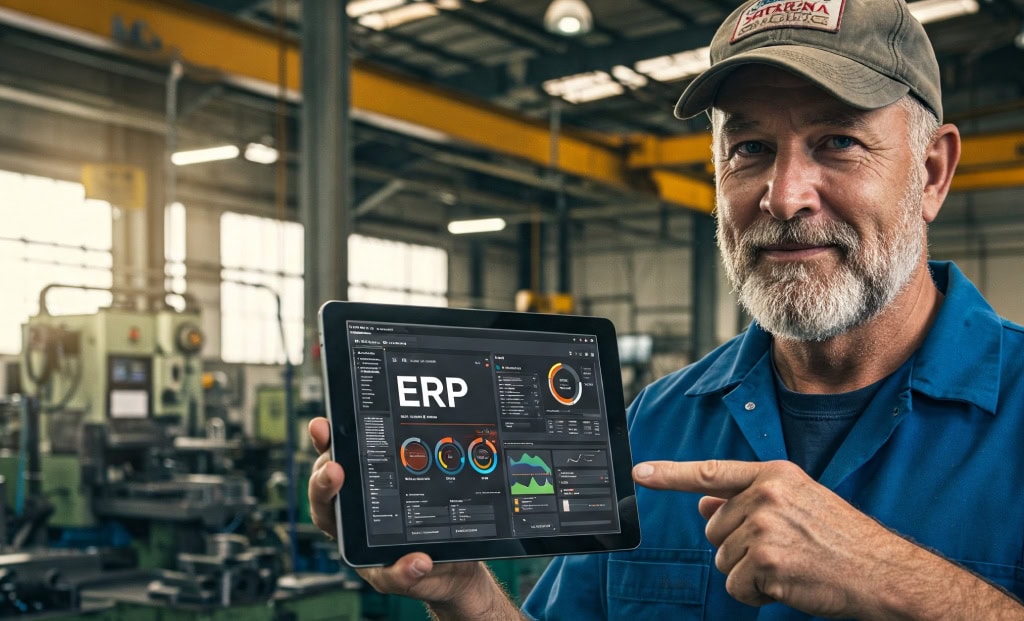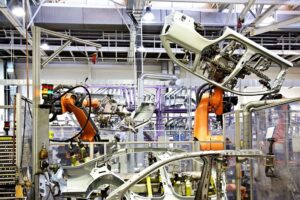Not later, but NOW!
Seize the Momentum in U.S. Manufacturing
The American manufacturing sector is at a pivotal moment.
From increased government support to rising demand for localized supply chains, there’s never been a more promising time to optimize manufacturing operations and scale your business. However, with great opportunity comes the need for greater efficiency, operational visibility, and cost control. That’s where Enterprise Resource Planning (ERP) software comes in.
If you are still relying on silo-based systems, spreadsheets, notebooks, and manual operations, here’s the sad truth: You are already behind! The time to get an ERP for your business is not tomorrow, next month or year, not after your next big order – it’s NOW.
Why Now?
U.S. Manufacturing is Making a Strong Comeback
Thanks to the push for Made-in-America goods, political support, geopolitical shifts and supply chain disruptions, the need for self-sustenance in US manufacturing is seeing strong support.
Recent industry reports indicate that the reshoring of manufacturing jobs has quadrupled in the past few years. As federal policies pour billions into manufacturing infrastructure and technology, new business opportunities and demand are exploding across all sectors.
ERP is No Longer a Luxury. It’s a Necessity!
Legacy ERP software used to be expensive, difficult and time-consuming to implement, and reserved for large organizations. That era ended long ago.
Modern, tech-based, cloud ERP solutions are affordable, scalable, and specifically designed for each industry. Whether you are a metal fabricator from Detroit, a defense manufacturer from California, or a medical manufacturer from Ohio, there is an ERP specifically suited to your enterprise’s needs.
Today’s ERP systems are easy to procure, implement, and customize, requiring little time and effort. They can automate workflows, eliminate manual operations, and improve collaboration, utilization, and efficiency throughout the organization, eventually lowering costs.
Gone are the days when ERP used to be a luxury. Today, it’s a necessity.
Data-Driven Decisions is the Key
Today, manufacturing is all about smart operations. Real-time data visibility is everything in manufacturing. From tracking inventory levels to monitoring machine performance and utilization, to getting supply chain updates, to tracking yield and scrap quantity.
This empowers you to take swift, smart and timely decisions that take you ahead of your competitors in a fiercely competitive US manufacturing industry.
Top Benefits of ERP for U.S. Manufacturers
Improved Organizational Efficiency
An ERP automates manual, repetitive tasks, streamlines workflows and eliminates data duplication. It brings all manufacturing departments, such as finance, inventory, production, sales, purchases, shipping and services under a unified digital roof. This improves communication, collaboration, and overall efficiency, enabling your business to function smoothly without any disruptions.
Sustainable Supply Chain and Material Management
Supply chain is volatile and subject to geopolitical currents, environmental incidents and government policies. Therefore, getting a real-time visibility of your supply chain is non-negotiable. With an ERP, you can track materials from procurement to product delivery in real-time, allowing you to schedule production and other manufacturing operations accordingly.
An ERP allows you to –
- Efficiently manage demand forecasting and prevent material stockouts and overstocking.
- Automate supplier management and purchase orders.
- Track inventory in real-time to reduce wastage.
- Automate warehouse operations, storage and transportation.
- Improve communication, collaboration and compliance with vendors.
- Track materials and products throughout the supply chain for better quality control.
With an ERP, enterprises can reduce wastage and costs, enhance agility and on-time delivery, and stay sustainable at the same time.
Regulatory Compliance
An ERP enables you to completely adhere to critical industry standards such as TS/ISO 16949 (Automobile), AS9100 (Aerospace & Defense), TS13485 & ISO 9001 (Medical Equipment), US GAAP and IFRS (Industrial Machinery) and more.
These industry standards also require enterprises to adhere to environmental regulations by monitoring waste, disposal and carbon emissions, which an ERP helps them to do.
Resource Optimization
With an ERP, enterprises can optimize resource utilization by tracking inventory, labor, machine performance, scrap quantity etc., in real time and take proactive measures in case of any deviations from the usual operating procedure.
With efficient production control, enterprises can reduce wastage and energy consumption to a large extent.
Go Green with Paperless Operations
OmegaCube ERP automates manufacturing and distribution workflows, eliminating the need for paper-based operations. Every process and documentation is digitized within the ERP, thereby reducing overhead costs for relevant office supplies, stationery and other miscellaneous costs.
Asset Lifecycle Management
With an ERP, manufacturers can easily extend the life of assets such as machines, parts, equipment, tools, etc., leading to reduced costs, improved reliability and operational efficiency.
They can extend asset life with,
- Proactive maintenance scheduling
- Real-time monitoring of assets
- Predictive maintenance with machine monitoring systems
- Optimized resource allocation
- Inventory & spare parts management
- Compliance and documentation
Enterprises can reduce repair and maintenance costs, minimize machine downtime and production disruptions, maximize asset ROI and improve overall performance.
Scalability and Growth
With an ERP automating your workflows and business processes, you get the ability to take up more jobs and expand without having to worry about being held back by your systems.
An ERP adapts to the way you operate and scale as you grow.
With various manufacturing functions such as inventory, finance, HR, production, etc., seamlessly working with the help of an ERP, you get better inventory control, reduced downtime and optimized resources that directly impact your bottom line.
What Happens If You Wait?
Delaying ERP adoption doesn’t just slow your growth—it risks your existence and market relevance.
As your competitors digitize and automate their enterprise operations to move rapidly ahead, your business suffers as a result of manual processes and errors draining your valuable time and money. Not investing in technology will prove costly, and you will be left behind.
How to Get Started?
- Evaluate your pain points – Are you struggling with inventory accuracy? Constantly missing delivery deadlines? Facing increased costs due to inefficient cost tracking?
- Research industry-specific ERPs – Look for ERP solutions designed for discrete or process manufacturing, depending on your needs.
- Get buy-in from top leadership – ERP isn’t just an IT project; it’s a strategic business initiative.
- Choose an ERP that is easy to implement – It might just save you immense time, money and resources. Easy to implement doesn’t only mean a plug-and-play ERP, it also means that the ERP vendor’s implementation process is robust, time-tested and proven.
Conclusion
America’s manufacturing revival is real, but it rewards those ready to adapt. Implementing an ERP system is no longer just about tech; it’s about strategy, agility, and future-proofing your business.
The time to get an ERP isn’t later—it’s now. Don’t let opportunity pass you by while you wait for the “perfect time.” In manufacturing, as in life, fortune favours the brave.
Over the past 25 years, OmegaCube ERP has been the beacon of innovation, technology-led workflow automation and a growth enabler for many manufacturing and distribution enterprises in the U.S.A.
Get in touch with us for an in-depth demo of OmegaCube ERP.






One Response
Just exploring your services